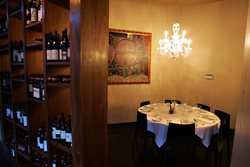Whoever designed the moody, dramatic lighting at Barolo Ristorante deserves a Tony Award. A constellation of tiny halogen stars splays across the ceiling; the alabaster bar emits a lunar glow. A single white candle, set into the drippings of its predecessors, lights each table, outlining diners in chiaroscuro, heightened by the black-and-white lines of the modernist decor. A line of candelabras stretches the length of a 20-seat communal table, which looks like something out of The Hunger, and above the vampire’s banquet, the crystal teardrops on a row of chandeliers cast flecks of white light in a thousand different directions. Any producer hoping to turn The Phantom of the Opera into dinner theater should give this place a call.
The romance of the room is palpable. And my hopes for Barolo’s food were high, given that the owners, the Varchetta family (of Mamma Melina, Buongusto, and Leo Melina), claim that the restaurant showcases the cuisine of the Barolo region in northwest Italy.
I spend a lot of time complaining about restaurants that serve a standard menu of “Indian” or “Italian” food, as if they can sum up an entire nation’s cuisine in 12 dishes that only Americans recognize (you think you can find chicken tikka masala in New Delhi or pasta primavera in Florence?). So the idea of a kitchen specializing in such a small region of Italy suggested that the food would exude personality, terroir, depth.
Sadly, it didn’t work out that way. Sure, chefs Michele Godina and Riccardo Simeone have eschewed the tomato sauces and rustic Mediterranean notes of southern Italy in favor of mushrooms, beans, bitter greens, and lots of northern Italian red wines. But I still didn’t come away from my meals at Barolo feeling a sense of place.
A few dishes were outright disasters, such as scallops completely wrapped in prosciutto, which were sautéed until the cured meat crisped up—which meant by that time the scallops had overcooked (and tasted offensively salty to boot). A dessert mislabeled “panna cotta” turned out to be milk Jell-O topped with a bizarre mocha-hazelnut something, which had the texture of muesli mixed with yogurt. But most dishes simply lacked a spark, that mysterious convergence of flavors that all one’s memories of a good meal coalesce around.
Both the endive, arugula, and radicchio salad and the string bean, goat cheese, tomato, and roasted pepper salad were dominated by their vinaigrettes. The osso buco, a braised veal shank, was certainly tender, but not so delicious that I melted into my chair; I largely contented myself with the big, saffron-scented risotto Milanese from the shank’s periphery. Risotto with prawns, clams, and mussels had a proper firm-creamy texture, but its flavor was monochromatic.
Two of the most assured dishes I tried were really American bistro classics. The misto fritto was a tangle of frilly, battered squid, shrimp, zucchini logs, and apples; we dipped the light, crunchy fried things in tomato and oh-so-Italian tartar sauces. The chocolate soufflé? A stellar rendition of good ol’ molten chocolate cake.
Fresh, housemade pasta is what the owners promise, and it’s certainly their strength, no matter what the chefs do to it once it’s cooked. The most memorable dish of my visits was the porcini-stuffed tortelloni alla Piedmontese, little hat-shaped packets whose wrappings were the perfect al dente. This pasta had presence. So did the halibut ravioli with a tomato-cream sauce—too bad the sauce was so salty that it spoiled the effect. And soft, light housemade gnocchi with Barolo-braised beef all but deflated on the tongue, which, again, helped redeem their coverings: You’d think “Barolo-braised beef” would be a sugo of long-simmered meat melting into a sauce so rich you’d lick it off a rusty nail, not steak strips in an acidic red-wine reduction.
Of course, wines aren’t the only world-famous products of the Barolo region. So are truffles, the nubbly underground fungus balls that are worth more, per ounce, than your liver on the black market. If there’s one word that can make a foodie’s nose twitch, it’s “truffle,” and truffles appear in close to one-quarter of the dishes. Sometimes, as in the black truffle risotto, they’re put to good use. The truffle-leek cream sauce on the porcini tortelloni was enticingly restrained, a low bass note thrumming underneath the rich baritone of the pasta’s dried-mushroom stuffing. Other times, the cooks seemed to add truffles for truffles’ sake. After eating a few bites of a mixed greens and fennel salad with white-truffle dressing, I questioned whether the brawny, swaggering flavor of truffles and the willowy, anise-tinged crunch of raw fennel should even be in the same room together, let alone the same bowl.
The Varchettas have been operating successful Italian restaurants in Seattle for 20 years, so it’s no surprise that they’ve mastered the art of ambience. But the care and precision that has clearly gone into the lighting isn’t echoed in the food. There’s not much drama on the plate at Barolo. They only provide the backdrop; you’ll have to stage your own production.






